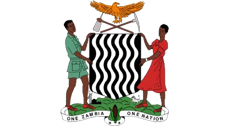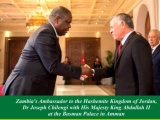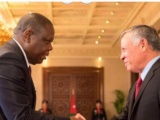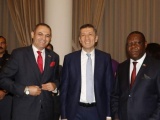About Zambia
Useful Links
Friday, 17 April 2015 01:56 Written by Super UserGovernment
Central Statistics office
Immigration Department
Mining sector
Registration of Companies and Patents
Zambian Parliament
State House
Quasi-government
Bank of Zambia
Zambia Revenue Authority
Zambia Development Agency
Energy Regulation Board
Lusaka Stock Exchange
Zambia International Trade Fair
Associations
Zambia Association of Chambers of Commerce and Industry
Zambia Export Growers Association
Zambian Embassies and High Commissions
Zambia High Commission-London, UK
Zambia High Commission- Pretoria, South Africa
Zambian Embassy- Rome, Italy
Zambian Embassy-Stockholm, Sweden
Zambian Embassy- Tokyo, Japan
Zambian Embassy-Berlin, Germany
Contact
Thursday, 16 April 2015 14:18 Written by Super UserAddress: 5th Alhursh Street - Um Somaq Amman Jordan
B.O Box: 1235 - Area Code 11821 Amman
Telefax: +962 6 55 20 55 4
Mobile1: +962 79 520 5 520
Mobile2: +962 77 520 5 520
Email:
This email address is being protected from spambots. You need JavaScript enabled to view it.
Web: www.Zambia-jo.com
Geography
Thursday, 16 April 2015 13:58 Written by Super Userambia takes its name from the Zambezi River, which rises in the north-west corner of the country and forms its southern boundary. This landlocked country lies between the latitudes 10o and 18oSouth and longitudes 22o and 33o East.
It’s neighbours are: Congo DR to the north and north west, Tanzania to the north east, Malawi to the east, Mozambique to the south east, Zimbabwe to the south, Botswana and Namibia to the south west and Angola to the West.
Zambia’s 752,000 square kilometres makes it a large country about the size of France, the Netherlands, Belgium and Switzerland combined. It consists for the most part of a high plateau, with an average height of between 1060 and 1363 meters above sea level. (3500 and 4500 ft). Isolated mountain ridges rise to more than 6000 ft with an occasional peak above 7000 ft on the eastern border, called Nyika Plateau. Over most of the country the surface tends to be flat, broken by small hills, the result of countless ages of undisturbed erosion of the underlying crystalline rocks. These rocks contain the bulk of the country’s wealth in the form of minerals, and the 90 mile long corridor known as the Copperbelt, along the north-western part of the country, is the mainstay of the Zambian economy.
The level of the land falls southward from the Congo DR / Zambezi divide in the north towards the Zambezi depression in the South. The plateau is broken by the huge valleys of the Upper Zambezi and its major tributaries, of which the Kafue and Luangwa Rivers are the largest. One result of the plateau formation of Africa generally is the swift discharge of water towards the coast and the interruption of the rivers by waterfalls and rapids. This has made them of little value for transport over their length, but very suitable for hydroelectric schemes and white water rafting adventures.
With the exception of the Northern and Luapula Provinces which are part of the Congo DR basin, Zambia lies on the watershed between the Congo DR and Zambezi River systems. The three great natural lakes of the country, Bangweulu, Mweru and the southern end of Lake Tanganyika are all in the north and are part of the headwaters of the Zaire River. Lake Tanganyika is the second deepest natural lake in the world.
Lake Bangweulu, which with its swamps covers an area of about 3800 square miles, is drained by the Luapula River. This river starts flowing south, then turns west and northwards to pass through Lake Mweru on its way to Congo DR.
Along the southern border of the country stretches Lake Kariba, the largest man-made lake in Africa and the second largest in the world. It is about 280kms long and 40kms across at its widest point.
About Zambia
Thursday, 16 April 2015 13:52 Written by Super Userormerly called Northern Rhodesia as an integral part of Cecil Rhodes’ Cape to Cairo vision, Zambia is in fact steeped in history dating all the way back to the African Stone Age. However, in many ways the famous Scottish missionary David Livingstone put the country on the European map as he came to the shores of Lake Tanganyika in search of the source of the Nile in the early 19th century.
Whilst Zambia is now one of Africa’s most urbanised countries, much of the country remains wild, underdeveloped and unspoilt, with a great percentage of land allocated by the government to conservation projects, national parks and game management areas. Many of these parks are home to incredible numbers of Africa’s most-feted wild mammals and extraordinary birdlife.
Zambia’s remaining open rural areas are, for the most part, rich and fertile, with Zambia’s consistently warm tropical climate made less oppressive by the altitude of many parts of the country. One of the most water rich countries in Africa, Zambia has 5 vast lakes, 3 major rivers, 17 waterfalls and various wetland areas. .
Many of Zambia’s 72 ethnic groups still inhabit these rural areas, relying on subsistence farming to get by.
Zambia is one of the fastest growing economies on the African continent and tourism is crucial to the country’s on-going development.







